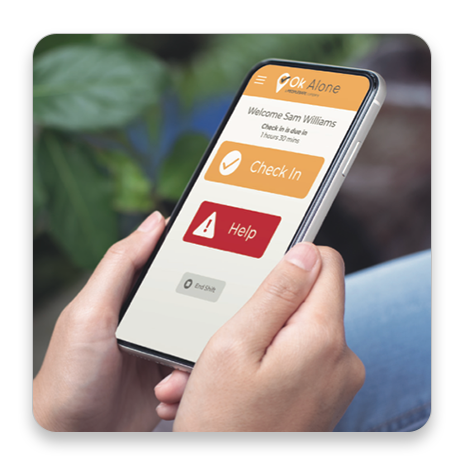
How a Lone Worker Alarm Can Ensure Safety and Peace of Mind with 24/7 Protection
Lone Worker Alarms
Employees who work in remote or isolated environments without direct supervision or easy access to immediate assistance are referred to as lone workers. These workers face distinctive safety challenges and ensuring their safety and well-being should be a top priority for employers who have a legal and moral responsibility to protect their workers. One solution to enhance the safety of lone workers is the use of a lone worker alarm system, which provides 24/7 monitoring and protection.

What are the different types of lone worker alarms?
With many industries requiring slightly different approaches, there are a variety of alarms with a wide range of features that help protect lone and remote workers.
Smartphone
Voice Activated
Wearable
Desktop Alarm
Lanyard ID
Bluetooth Alarm
Wi-fi Alarm
FAQ's About Lone Worker Alarms
A lone worker alarm is a device that uses modern technology to provide monitoring and an alert system for people who work remotely or on their own. The main way that a lone worker alarms protect employees is by alerting others to their situation and cutting down the response time in an emergency. The response time is crucial as it can reduce the notification time of an injury to mere minutes, and could mean the difference between life or death for someone on their own. These systems are equipped with features like GPS tracking, which helps locate the worker’s exact location and facilitates an emergency response. Other features may include panic buttons, fall detection sensors, and two-way communication systems, allowing for a timely and efficient response to emergencies.
In a lot of countries, states and provinces having a lone worker device for staff is a legal obligation for employers. This is because what might be a minor incident to someone in a crowded office, can become a critical situation or medical emergency to a lone worker. Having a way of letting other people know they are in a risky situation or that there has been an accident is vital. Using a lone worker alarm system gives the added security to any remote worker across an array of industries that someone will send help, or contact the emergency services, if needed.
While lone workers are not at higher risk of having an injury than others in their industry, people in lone working situations are more vulnerable than those who work as part of a team. The personal alarm can be used by a worker in distress to request immediate help from their supervisor. If an employee was working alone at a shop counter late at night and a customer started acting in a threatening manner, the employee could get out their phone, click on the app and tap the ‘help’ button to let other staff know they needed assistance. This action could also be done as a discreet alert in a way (shaking or tapping) that does not draw attention to the employee’s actions. Equally, if a lone worker was working remotely from home and ended up pinned under a bookcase after a fall or an earthquake, they could use the voice command feature of their lone worker alarm to get help. The lone worker alarm’s main purpose is to alert others to a lone worker’s needs in an unpredictable situation. A desktop/pc based lone worker alarm system would be very helpful to a receptionist alone in a hotel lobby. They can click on the icon at the bottom of their screen and select help on the pop up, all with the tiniest movement of their hand on the mouse.
Panic alarms for lone workers work by pressing a simple button on a lone worker device or app. When the alarm is triggered, the assigned staff monitor will be notified immediately via SMS, email, phone call or Whatsapp. Important information, the worker’s escalation procedure, (their phone number and GPS location), will be sent to the monitor so they can ensure assistance is sent directly to the worker in need. Monitoring can be carried out in-house by the employing company or via a call centre. If monitoring in-house, the company will assign a monitor, or group of monitors, who will receive notifications of an alert and will know how to respond according to the company’s lone worker policy. If monitoring via a call centre, the centre will receive the alert and following the individual worker’s procedure, escalate to the right channels, within the company directly.
Ok Alone is the perfect low-cost lone worker alarm system that ensures workers safely complete each shift. The all in one solution is a simple app (which doesn’t require additional hardware) that connects workers at risk with a supervisor who monitors their health and well-being. The Ok Alone system has a wide range of features designed to make any staff working remotely feel safer. An automated countdown timer, as required by work alone legislation and the duty of care, will remind an employee to check in at regular intervals using either the smartphone app, SMS or a phone call. Key features, like Man down detection and high risk check ins, give staff an increased sense of security. Ok Alone’s smartphone app works in conjunction with a website and cloud-based dashboard that can be used on a pc, laptop, tablet or any smartphone. The online dashboard will display a map with the workers last known GPS location if an alarm is triggered. A unique feature of the Ok Alone solution is its ability to be used completely hands-free with voice commands. Android or iPhone verbal short cuts can be programmed into the app, allowing workers to start shifts, check in and most importantly, request help without touching their phone.
Book a Demo Today
Alternatively, get a free trial of the app
Want to try OK Alone? Click the button below and enter your details. It's free and no credit card is required.
